Memphis Beyond Graceland: The National Civil Rights Museum
Last updated on January 14th, 2024 at 09:16 pm
On April 4, 1968, Dr. Martin Luther King Jr. was assassinated at age 39 by James Earl Ray in Memphis, Tennessee, as he stood on the balcony outside his room at the Lorraine Motel.
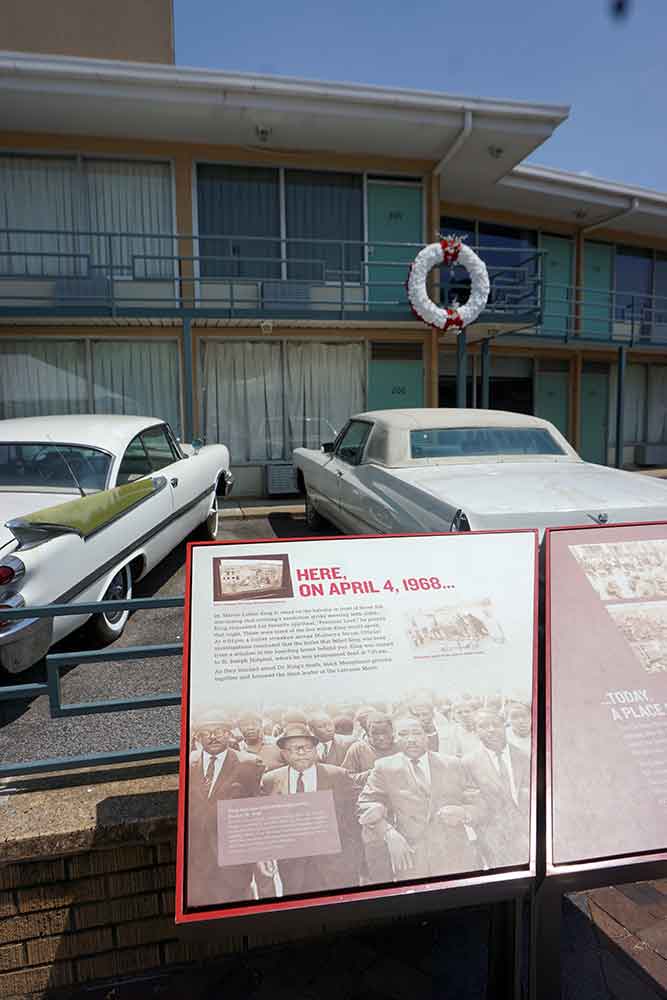 Here, on April 4, 1968…
Here, on April 4, 1968…
(Text of the sign in the photo above) Dr. Martin Luther King Jr. stood on the balcony in front of Room 306, discussing that evening’s sanitation strike meeting with aides. King requested his favorite spiritual, “Take My Hand, Precious Lord,” be played that night. Those were some of the last words King would speak.
At 6:01 p.m., a bullet streaked across Mulberry Street. Official investigations concluded that the bullet that felled King was fired from a window in the boarding house across the street. King was rushed to St. Joseph Hospital, where he was pronounced dead at 7:05 p.m., April 4, 1968.
In memory of Dr. King, listen to that hymn now, “Take My Hand, Precious Lord,” as Elvis Presley recorded it on one of his several gospel albums.
National Civil Rights Museum Opens in 1991
Twenty-three years later, in 1991, the National Civil Rights Museum opened on the site of the Lorraine Motel, with the mission of sharing “the culture and lessons from the American Civil Rights Movement” through interactive exhibits, historic collections, and “exploring how this significant era continues to shape equality and freedom globally.”
Five centuries of history are covered — from the beginning of the resistance during slavery, through the Civil War and Reconstruction, the rise of Jim Crow, and major events of the late 20th century that have inspired people around the world to stand up for equality.
See Slideshow:
Dr. King had been named Time Magazine’s Man of the Year in 1963. He was the first African-American recipient. On August 28, 1963, during the March on Washington for Jobs and Freedom, he gave his “I Have a Dream” speech to a crowd of 250,000 demonstrators who marched to the Lincoln Memorial. The following year, 1964, Dr. King was awarded the Nobel Prize for Peace “for his non-violent struggle for civil rights for the Afro-American population.”
The Rise of Jim Crow
The Rise of Jim Crow exhibit was particularly poignant for me, as someone who was born in the early 1950s. I had heard the term but didn’t really know what it meant. I learned that Jim Crow laws enforced racial segregation in the South between the end of Reconstruction in 1877 and the beginning of the civil rights movement in the 1950s.
President Lyndon Johnson signed the Civil Rights Act on July 2, 1964. This finally abolished Jim Crow laws. It invoked the commerce clause, outlawing discrimination in public accommodations. The Voting Rights Act followed in 1965; effectively giving black people the vote
I’ve Been to the Mountain Top
King had traveled to Memphis in support of striking African American city sanitation workers. The previous evening he delivered a speech at the Mason Temple that has become known as the “I’ve Been to the Mountain Top” address, which said, in part:
“…I just want to do God’s will. And He’s allowed me to go up to the mountain. And I’ve looked over. And I’ve seen the promised land. I may not get there with you. But I want you to know tonight, that we, as a people, will get to the promised land! [applause] And so I’m happy, tonight. I’m not worried about anything. I’m not fearing any man. My eyes have seen the glory of the coming of the Lord.”
Museum Renovations Underway
In 2013 and 2014, the museum underwent a $27.5 million renovation, adding more than 40 new films, oral histories and interactive media. Groundbreaking for another major renovation was held in May 2023 for the museum’s planned Founders Park and Legacy Building. It will go next to the existing museum at the Lorraine Motel. The theme of the Legacy Building will be Dr. Martin Luther King Jr.’s last book, Where do we go from here? Chaos or community? According to Dr. Russell Wittington, National Civil Rights Museum President, the renovations are expected to be completed by the middle of 2025, ideally by Juneteenth 2025.
A Special Exhibit…
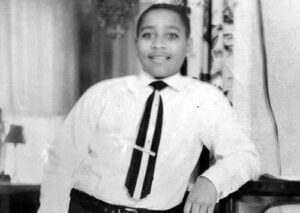 My most recent visit to the Museum was in November 2023. Although going through the museum again was very impactful, I was also able to go through a special exhibit on Emmett Till. The 14-year-old was kidnapped, tortured, and murdered by white supremacists in the Jim Crow South in 1955. Although the touring exhibit entitled, “Emmett Till & Mamie Till-Mobley: Let the World See,” is now closed, you can take a virtual tour at this link: https://emmetttillexhibit.org/
My most recent visit to the Museum was in November 2023. Although going through the museum again was very impactful, I was also able to go through a special exhibit on Emmett Till. The 14-year-old was kidnapped, tortured, and murdered by white supremacists in the Jim Crow South in 1955. Although the touring exhibit entitled, “Emmett Till & Mamie Till-Mobley: Let the World See,” is now closed, you can take a virtual tour at this link: https://emmetttillexhibit.org/
This was the exhibit’s seventh and final stop. It will now be permanently displayed at the Emmett Till Interpretive Center, steps away from where the trial for his murder took place in the Second District Tallahatchie County Courthouse in Sumner, MS.
Hours and information about visiting the National Civil Rights Museum in Memphis are at this link:
https://www.civilrightsmuseum.org/visit
(Photos: © Debbra Dunning Brouillette unless otherwise noted.)
Personal Reflections…
I have now visited the National Civil Rights Museum twice, most recently in November 2023. I would encourage anyone planning to visit Memphis to put this on your “must do” list… beyond Graceland, beyond Sun Studio, and all the other “must-do’s” that I have visited and no doubt will again.
My first visit to this Museum was in July 2017 when my husband and I spent several enlightening hours walking through the interactive exhibits and historic collections, culminating with a walk by the actual room in the Lorraine Motel where King was staying on the last night of his life. Across the street, James Earl Ray stood in what was then a boarding house and fired the fatal shot as Dr. King was standing on the balcony outside his room with aides.
It made be think a lot about growing up in a small town in Southern Indiana. I was mostly sheltered from the reality of segregation. My classrooms were integrated from the start. While there weren’t many black families in the town I grew up in, we all got along. I wasn’t aware of what the reality of life in America was like for many black Americans.
I still recall driving through the South on our way to Florida and stopping at a Dairy Queen type of place where you ordered your take-out food from a window. There was a separate window for “Colored,” which I didn’t understand. I remember seeing separate bathrooms for “Colored,” too. As a young girl, I was confused and couldn’t understand why… Those memories have stayed with me to this day.
Related Memphis posts:
Visiting Memphis and Elvis Presley’s Memphis Entertainment Complex


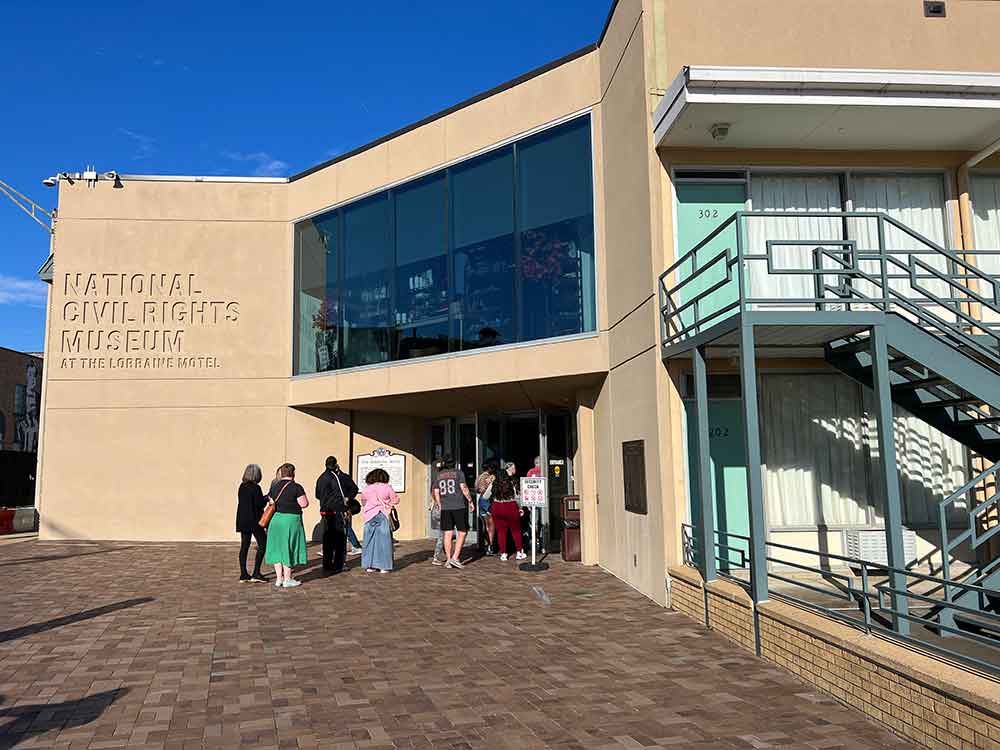
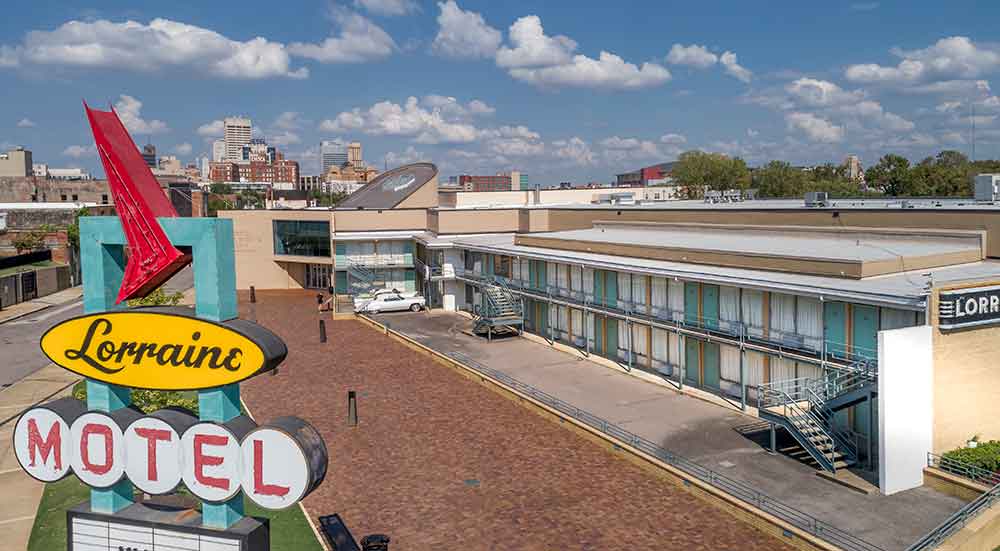
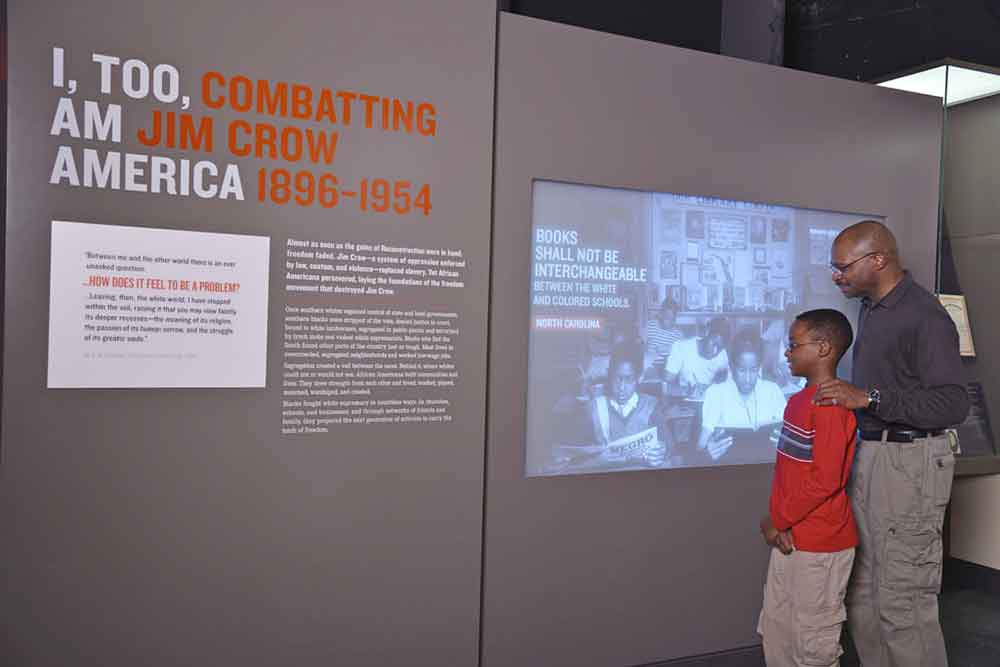
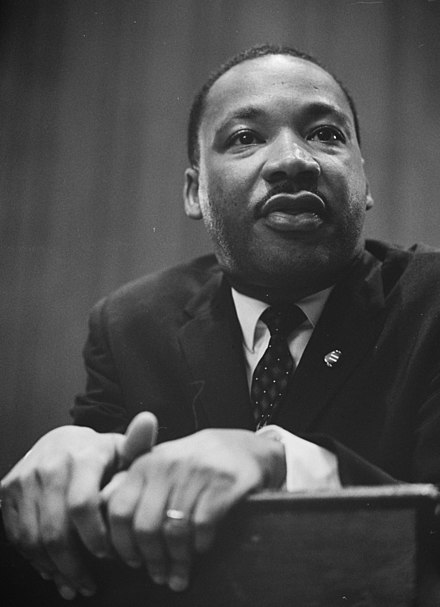
Your good museum review is of course, very topical with today being the anniversary of Martin Luther King’s “I Have a Dream Speech” and tomorrow, the anniversary of his tragic murder. I have to admit that Elvis Presley wouldn’t draw me to visit Memphis, but this museum might. Like you, I drove through the deep South of the United States before the abolition of Jim Crow. However, even at age 9, I did understand because my parents were civil rights activists. My father had even taken me to do fair housing testing. We would go to an apartment complex and ask to see an apartment with certain specifications. We’d be shown three. Shortly after or before, a black family with exactly the same requirements would ask about renting an apartment and would be told none were available. The Deep South? No. Philadelphia, Pennsylvania in the late 1950s and early 1960s.
Wow, Suzanne, how wonderful that you had that background and awareness, thanks to your parents, at such a young age! And to know that reality was also in Philadelphia is eye-opening, to say the least. Thanks for sharing that… (The “I Have a Dream” speech was actually delivered by King during the March on Washington for Jobs and Freedom on August 28, 1963, while his final address given the night before he died is usually referred to as “I’ve Been to the Mountaintop.” Easy to confuse the two!)
The National Civil Rights Museum will certainly be on my list of things to see if I go to Memphis. I was in my early teens when Martin Luther King Jr. was assassinated. The shockwaves from that reached us in Canada. I recall bits and pieces of other news stories about segregation and civil rights marches from that time period, but there is so much of this history I do not know well. I’m sure the museum would be an sobering enlightenment.
I think it WOULD be enlightening for you, Donna, as it was to me as well, as I grew up in the U.S.! As a child, my awareness wasn’t as heightened, but I also lived through the protests and marches when I was older. The museum is very well-done and I’m glad we didn’t skip it when we were there to visit Graceland, Beale Street and the other sites Memphis has to offer.
What great timing for a post about such a great man. He sure had a wisdom beyond his years. Wonder what the world would be like if Dr. King’s life hadn’t been cut short. I heard the museum director speaking on TV this morning and he was quite inspiring, too!
When I realized the 50th anniversary was coming up, I thought about our visit of last summer and decided now was the time to do a post. I had no idea the museum would be as extensive as it is, and now that the Legacy building is open across the street (former boarding house), it takes several hours to see it all. I’d now put it on a “must-see” list for Memphis.
Oh no! I went to Memphis for Graceland and the Sun Studio Tour was a kick. But how did I ever miss this? It’s been there since 1991! But I won’t castigate myself. I didn’t miss his birthplace in Atlanta with the eternal light!
Carol, no worries… Next time you’re in Memphis, you can go! This was my fifth time to visit Graceland over the years and was my first visit to this museum. It was greatly expanded in 2013 and 2014 so don’t think it was such a major museum until the last several years. I am, however, glad it was on our radar this time around!
Great post about the museum. I shared a quote from MLK in my yoga class today and focused the theme of the class around his words. I just saw that The NY Times wrote a piece about Memphis. So many go for Elvis but this museum seems more interesting to me.
Hi Judy and thanks for commenting. Glad you enjoyed the post! I will have to admit that my main reason for visiting Memphis is for the Elvis-related attractions, but there are many other things to attract visitors to Memphis and this is one that is sure to leave an impact.
What a timely and thorough piece about the museum and Martin Luther King! I didn’t even know it was in Memphis — just knew about Elvis, like mostly everyone else. Thanks for bringing it to my attention!
Thanks, Patti! Elvis is synonymous with Memphis, for sure. I remember driving by the Lorraine Motel just to see the site when I first visited Memphis many years ago but hadn’t made a point to visit the National Civil Rights Museum until my most recent visit last July. I didn’t realize what a large complex it had become and was quite impressed with all it had to offer. I’d recommend it to anyone planning to visit Memphis!
Thx for sharing this great facility with us, Debbie. It’s hard to believe it’s already been 50 years since MLK left us. I’m glad a museum has been created in his memory.
Yes, I am too, Darlene, and it is so well done! I’m glad the 50th anniversary of MLK’s death is bringing even more attention to the National Civil Rights Museum and am happy to help spread the word about it.
Need to get to Graceland-for this site and the others.
There are many reasons to visit Memphis, for sure! If you haven’t been to Graceland, you must go…and please don’t miss the National Civil Rights Museum while you are in town!
It hardly seems like 50 years since that tragic day when Martin Luther King Jr. was assassinated. I haven’t been to Memphis since my children were young; I must go back to examine all the impressive Civil Rights locations. Thank you for this excellent post!
Yes, Marilyn, a visit to Memphis and the Civil Rights Museum is definitely in order…and don’t forget to visit Elvis while you’re there! 🙂
Great post Debbra. I have to say that I grew up like you in a Midwestern integrated suburb. We had many African American students in our high school and we all seemed to get along pretty well. I guess I’m shocked every time I read a story about racial unrest, and I shouldn’t be. We still have a long way to go.
Thank you, Sue… We all have our own personal lens through which we view the world and I am glad I had the upbringing I had in Indiana while, at the same time, I have great empathy for those who grew up in times of such struggle for equality. While we do have a long way to go, I’m glad we have come such a distance from the time of my childhood in the 1950s and 1960s. The National Civil Rights Museum is a great teaching tool for us all.
The Civil Rights Museum would definitely be on my list if I ever got to visit Memphis. Much more interesting and poignant than anything to do with Elvis. We spent quite a lot of time in South Africa where the struggle for equality was and is still very real.
Thanks for stopping by to comment, Jo! Memphis has a lot to offer beyond Elvia and Graceland, and the National Civil Rights Museum is another important reason to visit.
I was wondering if the National Civil Rights Museum would be open during the current federal government shutdown, so I googled it. Not only is it open, it’s offering free admission to federal government workers during the shutdown.
I’m so glad to find that out, Suzanne! Thanks for checking it out and letting me know!
So many things to see and do in Memphis and this would be a definite must see. So much of our current history happened when I was so very young — as you noted — and terms that I’ve routinely heard and didn’t understand seem to have stemmed from that time. A most interesting and timely post!!
Thank you, Jackie, for your comments… I’m glad we finally made it to the National Civil Rights Museum on our last trip to Memphis. It really brought a lot of things I’d grown up with into focus.
I’ve never been to Memphis, but thank you for this timely post and highlighting Dr. King’s role in the city. I recently had the chance to visit the Center for Civil and Human Rights in Atlanta and left in tears after a very powerful experience. I imagine visiting the National Civil Rights Museum would be very similar. I do love the way you tied in Elvis singing the MLK hymn.
Alison, I’ll be sure to check out the Center for Civil and Human Rights on a future trip to Atlanta. So glad you enjoyed the post, including the gospel song by Elvis! As an Elvis fan, it was the perfect way for me to tie in the two…
Pingback: Looking for A Weekend Getaway? Our Writers Share Their Favorites - Food, Wine & Travel
Pingback: Memphis Beyond Graceland: Where to eat – gourmet to budget – Tropical Travel Girl
Pingback: Visiting Graceland and Elvis Presley’s Memphis™ entertainment complex – Tropical Travel Girl
Fascinating history. Wish I could be there.
I hope you will be able to make it there one day…